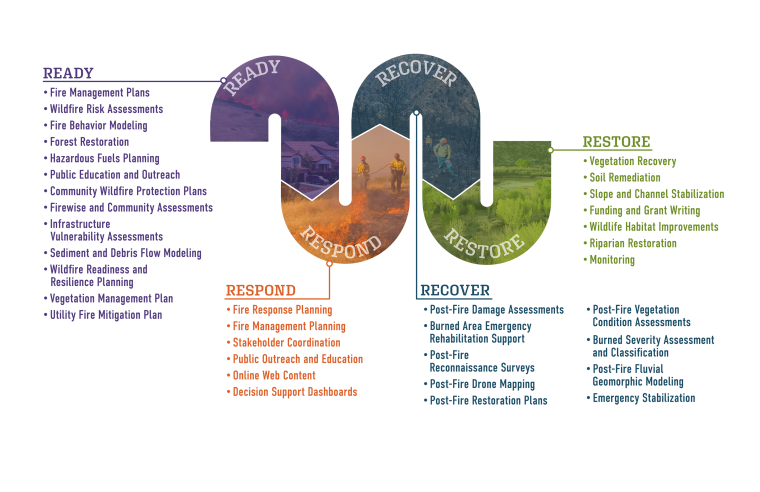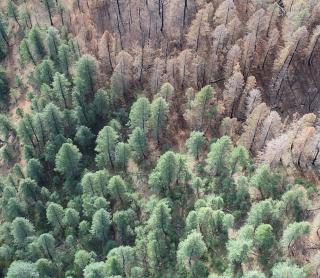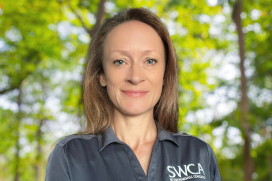THE NEXUS BETWEEN WILDFIRES AND WATER
As a naturally occurring phenomenon, wildfires have played a vital role in maintaining healthy ecosystems for thousands of years. Fires continue to serve this role, and prescribed burns are regularly used to promote ecological health and wildfire resilience. Low-intensity wildfires clear out dead vegetation and invasive species. They release nutrients that nourish the soil faster than waiting for plant and animal materials to decay, help kill pests and diseases, encourage the next generation of growth, and allow healthy parts of the ecosystem to thrive.
A healthy ecosystem, in turn, contributes to healthy watersheds. Fire can clear heavy brush and make room for grasses, herbs, and regenerated shrubs, encouraging a diverse community of plants that absorb, filter, and release water at different rates to sustain, and even increase, water resources.
“Many of the ecosystems we live in across the United States are fire adapted, and we must therefore adapt to fire. Native people have long demonstrated the role that fire plays in maintaining ecosystem health, and we should be learning from those practices so we can live with fire while still protecting the resources and assets that we value and depend on,” said Victoria Amato, a principal planner of fire and forestry at SWCA.
The natural role that fires play across our landscapes will vary by region, based on vegetation, topography, and weather, but the absence of wildfires can lead to an accumulation of flammable materials — dead trees, branches, and dry undergrowth — in addition to altering ecosystems and increasing the risk of larger, more destructive fires.
THE THREAT OF WILDFIRE TO OUR WATER RESOURCES
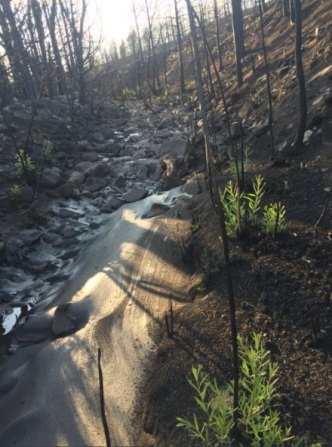 Sediment buildup in a riverbank
Sediment buildup in a riverbankUnfortunately, many of the wildfires in recent history have had far-reaching and devastating impacts, fueled by unfavorable conditions like extended periods of drought, hotter temperatures, and high winds. These intense wildfires are becoming an increasing threat to our water resources, from the effect on our drinking water supply and quality to entire shifts in our watersheds that our farmers, ranchers, and others downstream rely on.
Catastrophic wildfires— those that burn outside of their natural range of intensity— can transform stable soil into fragile, erodible remnants, which can lead to an increase in potential debris flows, landslides, and soil erosion during post-fire storm events. Soils become water repellent, increasing runoff volumes, which results in more sediment and ash being carried into streams, rivers, and reservoirs, and leads to increased turbidity in the water.
Debris, such as fallen trees and branches, deposited into waterways is another consequence of wildfires. Accumulation of debris can create dams in streams and rivers, causing water to pool and potentially overwhelm banks and downstream infrastructure. By removing a landscape’s protective vegetative cover, wildfires can increase an area’s vulnerability to severe flooding and erosional events. The impacts of large and uncharacteristically intense wildfires affect both communities living in the burned area and those living downstream.
“Wildfires threaten our water resources in several ways. Immediately following a wildfire, the ash and chemicals from suppressants can pollute nearby water sources. Then, during rain events, flooding pushes debris and sediment into waterways and can severely alter the flow pathways, damage infrastructure, and impact drinking source water,” said Mary Huisenga, principal watershed scientist at SWCA. “As debris obstructs water flow, vital channels essential for irrigation to support agriculture, ranching, and grazing become compromised. The impact also extends to essential infrastructure such as water treatment plant intakes and reservoirs, which may cease operation or face severe limitations.”
NAVIGATING THE POST-WILDFIRE WATER MANAGEMENT MAZE
Post-wildfire recovery poses a multifaceted challenge due to a confluence of factors. Water jurisdiction and management often become a complex web of responsibilities, with overlapping federal, state, and local agencies all having a role in ensuring water quality and availability.
“Water doesn’t often come from a source where our client has jurisdiction,” said Arianna Porter, project manager specializing in fire and forestry at SWCA. “Most likely, water sources come from areas where another entity is managing those systems and landscape.”
The distribution of water and its sources can be severely disrupted by wildfires, impacting the reliability of water supply systems for both urban and rural communities. Furthermore, the need for public education and outreach becomes paramount, as residents must be informed about the risks and best practices to protect their water sources.
Addressing water rights in the aftermath of wildfires can lead to contentious legal disputes, as water becomes an even more valuable and contested resource. Finally, building community resiliency in the face of future wildfires involves not only restoring the environment but also developing long-term plans and infrastructure improvements to safeguard water resources and ensure the well-being of communities in vulnerable regions.
POST-WILDFIRE FLOODING ASSESSMENT IN NEW MEXICO
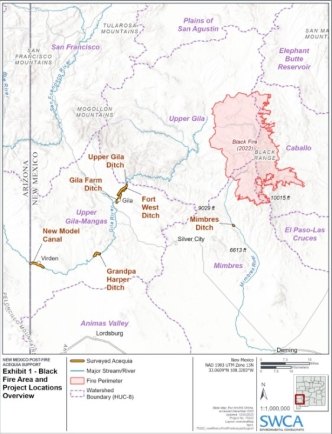 Black Fire area and project locations overview
Black Fire area and project locations overviewIn the spring of 2022, the second-largest wildfire ever documented in New Mexico’s history, the Black Fire, devoured 325,000 acres of New Mexico’s landscape. Only a couple of months later, the area experienced an above-average summer monsoon season with rains propelling sediment and debris into acequias.
“Acequias are community-operated water courses used for irrigation dating back to Spanish times and are largely important to the livelihood of culture and communities in Northern New Mexico,” said Cody Stropki, fire ecologist and service line director of resilience at SWCA. “Acequias are not only crucial for sustaining agriculture and ranching but also represent a living cultural heritage of the communities they serve and contribute significantly to the unique identity of New Mexico.”
The New Mexico Interstate Stream Commission hired a team of experts from SWCA to conduct a post-fire flooding assessment of 10 damaged acequias and their functionality within the Gila and Mimbres basins.
SWCA water resources specialists surveyed all 10 acequias and determined them to be dysfunctional — incapable of transporting water for its intended use downstream — either from becoming silted with sediment or because they had been bypassed completely with newly developed river channels.
SWCA’s team identified short-term solutions to reestablish the operable mode of the impacted acequias and developed a long-term plan to promote watershed health and flooding management.
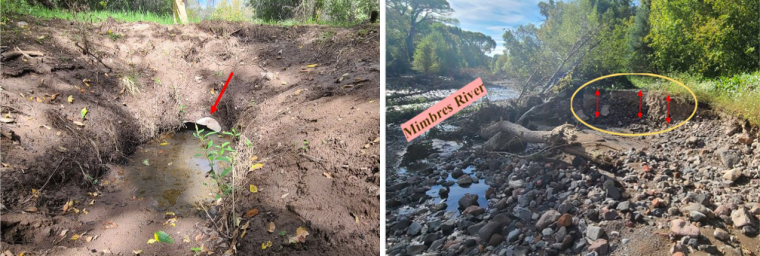 Left Image: Collapsed culvert at New Model Canal
Left Image: Collapsed culvert at New Model CanalRight Image: Mimbres River with vertical head cut erosion of the riverbank
WILDFIRE RESPONSE PLANNING AND WATERSHED SEDIMENT MANAGEMENT FOR A WATER UTILITY
Wildfire is a substantial risk for water utilities that directly depend on healthy forests and watersheds to serve millions of residents. For one such water utility, two catastrophic fires in the area’s history (a couple of decades ago) served as the turning point for the utility’s approach to forest management. After one of these high-intensity wildfires, heavy rains carried 40 years’ worth of sediment into a vital reservoir in a matter of days.
Today, continuing its dedication to safeguard the water supply through proactive measures, this utility worked with SWCA to better understand and prepare for potential wildfire through several means. In addition to detailing a wildfire response plan for one of the utility’s key reservoirs, SWCA fire and forestry specialists built an interactive wildfire readiness and response framework for use as a decision-support tool to improve fire response in critical areas of the watershed.
“The response plans and decision support tools that our team has been able to develop for clients like these, helps ensure that the utility is proactively addressing and mitigating the wildfire risk that their watersheds and infrastructure may face. And in the event of a wildfire, they have the measures in place to be able to minimize the impacts,” said Amato.
Although not as obvious as specific wildfire planning, managing sediment across the entire watershed is crucial to protecting drinking water resources. SWCA scientists identified the sediment transport and sources for one of the utility’s key reservoirs and developed a watershed-wide sediment management plan to prioritize sediment-stabilizing projects based on the sediment load and wildfire risk.
SAFEGUARDING OUR WATER RESOURCES
Collaboration and conservation efforts play a key role in restoring and protecting the delicate relationship between wildfires and water supply resources. SWCA brings together wildfire planning and water resources experts to address complex challenges posed by wildfires, before and after they occur.
Fire mitigation and planning is not merely a response to crisis; it is a testament to proactive, sustainable practices that protect water systems before, during, and after wildfires occur. By building partnerships across jurisdictions, connecting with communities, and creating innovative strategies, we can mitigate the impacts of uncharacteristically severe wildfires on natural resources and preserve the resilience of our environment for generations to come.
Successful resilience in the face of wildfires requires planning for all stages of the cycle: readiness, response, recovery, and restoration. SWCA provides a full suite of services and customized plans to meet your needs. Learn more about wildfire planning and water resources services and how our team of experts can navigate you through any stage.
